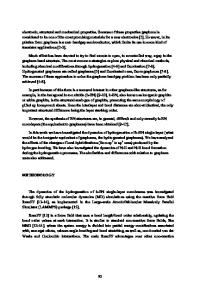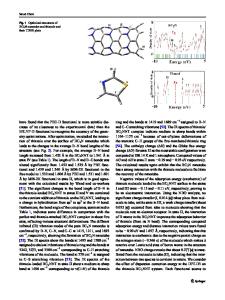A DFT study of healing the N vacancy in h -BN monolayer by NO molecules
- PDF / 1,344,184 Bytes
- 5 Pages / 595.276 x 790.866 pts Page_size
- 93 Downloads / 293 Views
RAPID COMMUNICATIONS
A DFT study of healing the N vacancy in h‑BN monolayer by NO molecules Hao Cui1,2 · Tun Liu3 · Pengfei Jia1 Received: 27 January 2020 / Accepted: 16 March 2020 © Springer-Verlag GmbH Germany, part of Springer Nature 2020
Abstract During the synthesis of h-BN nano-material, there unavoidably exist some N vacancies that will largely affect its physicochemical properties. Therefore, it is full of necessity to repair these defects before further investigations and applications. In this paper, we propose the use of NO molecules to heal the N vacancy in a h-BN monolayer through the NO disproportionation based on DFT calculation. Our calculations indicate that the repairing processes are energetically favorable and the repaired h-BN monolayer, from both geometric and electronic manners, has good similarity with the perfect counterpart. This theoretical work exhibits a promising approach to heal the N vacancy in h-BN monolayer, and we assume it is also feasible for repairing the N defects in other 2D nano-materials. Keywords N vacancy · h-BN monolayer · NO disproportionation · DFT
1 Introduction Very recently, two-dimensional (2D) nano-materials have raised significant attention because of their admirable physicochemical properties, such as large surface area, high carrier mobility and superior optical property [1–3]. After the discovery of graphene, scholars emphasize to find out other one-atom thickness 2D nano-materials with graphene-like structure and even better electronic property for extensive applications in many fields [4–9]. One of the most popular nano-materials is h-BN monolayer, which is widely studied for application of gas sensors [10], catalysts [11] and optics [12]. However, the inevitable existence of N defects in the nano-sheet during the practical synthesis may significantly impair its physicochemical property and thus limit its possible applications [13]. From this
* Hao Cui [email protected] 1
College of Artificial Intelligence, Southwest University, Chongqing 400715, China
2
State Key Laboratory of Power Transmission Equipment and System Security and New Technology, Chongqing University, Chongqing 400044, China
3
Traffic and Transportation Engineering, Central South University, Changsha 410083, China
aspect, the research community are making all the efforts to propose workable approach to resolve this issue [14–16]. An interesting manner is introduced in this paper to heal the h-BN monolayer, which includes a NO disproportionation using two NO molecules, and one NO will provide the N atom to heal h-BN monolayer filling one N defect. Specifically, the process could be illustrated as NO (g) + NO (g) → N (s) + NO2 (g). One can see that in this process, no catalyst is required and the N-defected h-BN monolayer behaves as the support to accept the N source from the reaction. Our research is based on density functional theory (DFT) method, which indicates that the whole reactions are fully favorable because of the low energy barrier that can be overcome at room temp
Data Loading...











